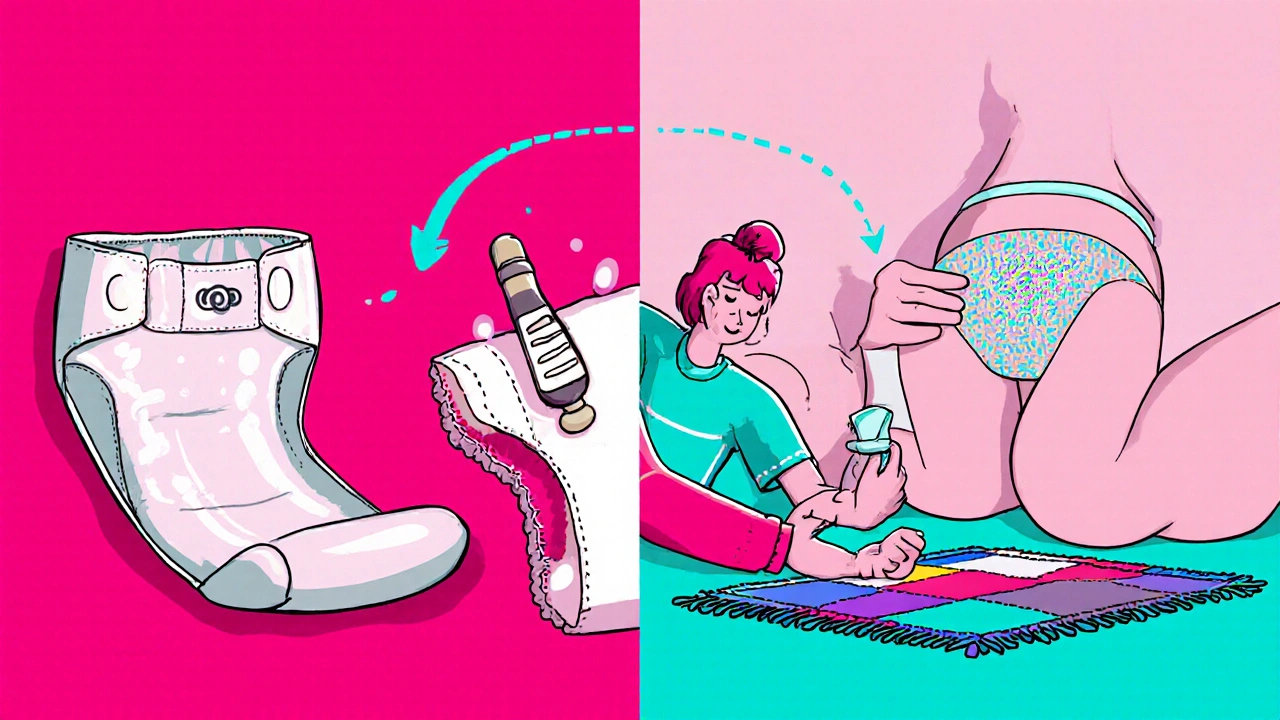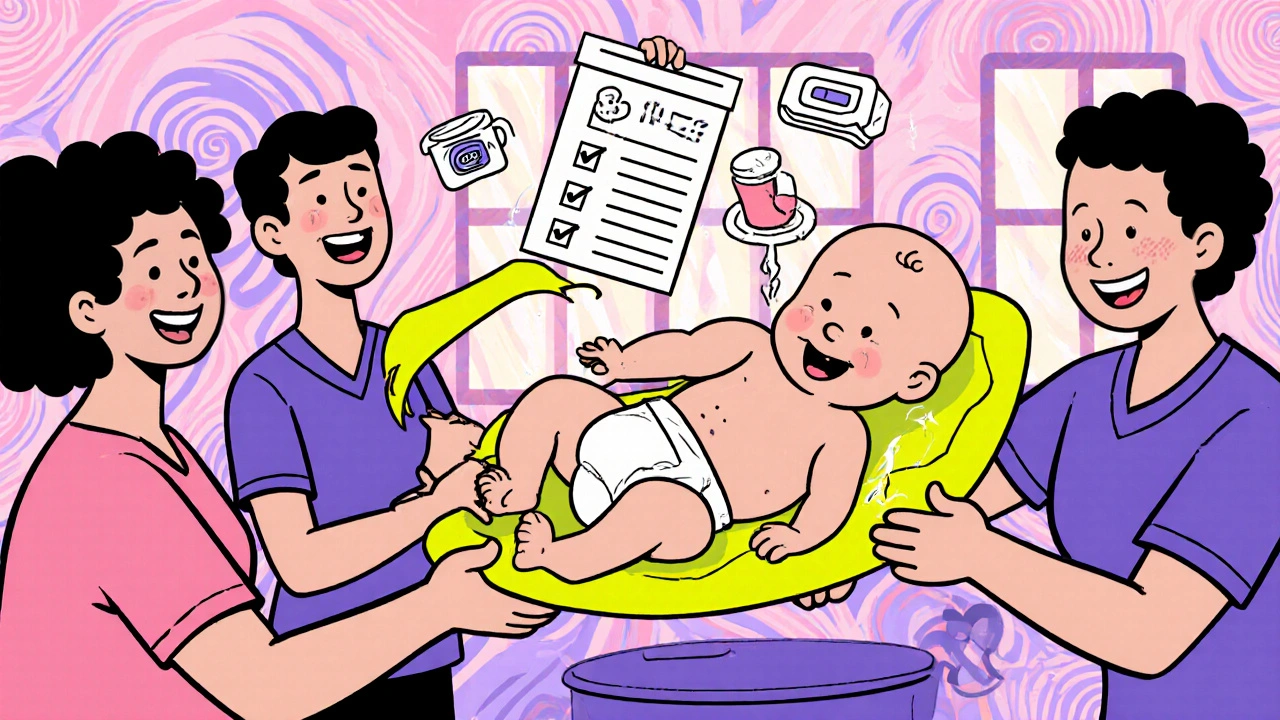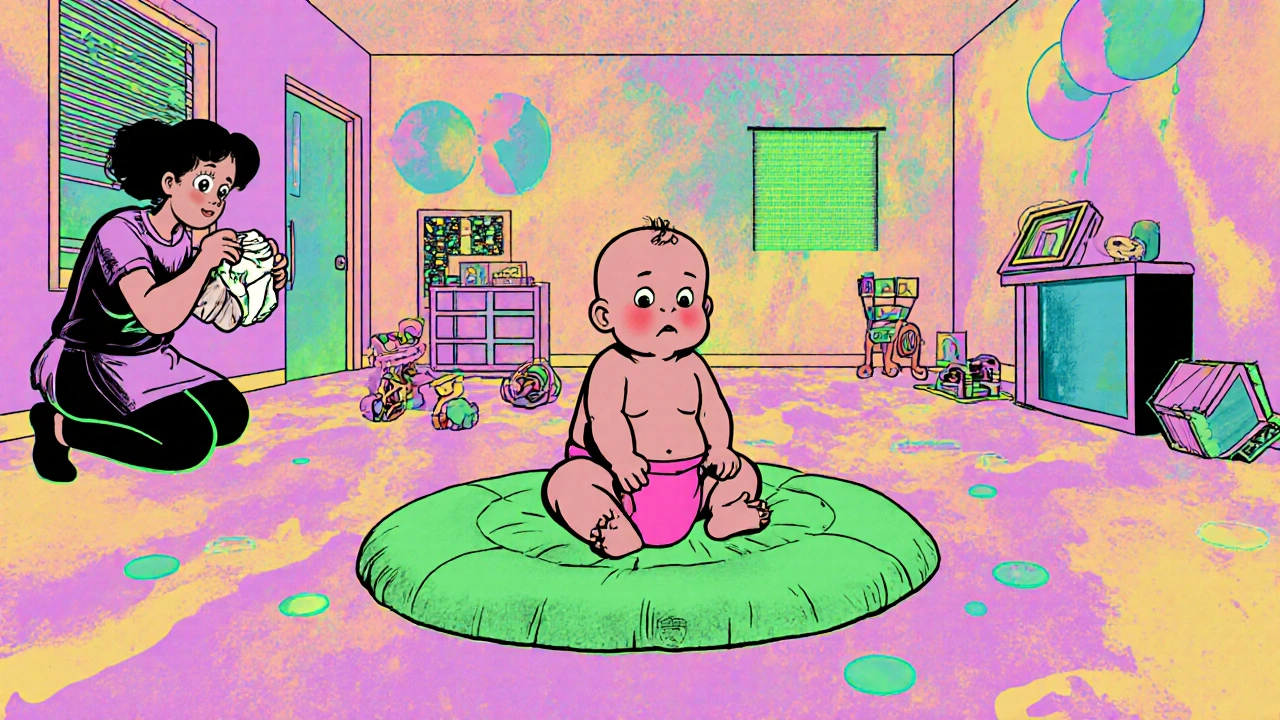Daycare Diaper Change Calculator
Calculate Your Baby's Ideal Daycare Diaper Schedule
Based on article recommendations, frequent changes prevent moisture-related rash. Input your baby's current schedule to get personalized recommendations.
Ever noticed your baby’s bottom turning red after a day at the daycare? That sudden flash of pink can feel worrying, but with the right routine you can keep diaper rash at bay and let your little one stay comfy all day.
What Is Diaper Rash?
Diaper Rash is a skin irritation that occurs in the diaper area, typically caused by prolonged moisture, friction, and contact with irritants like urine or feces. It usually shows up as redness, bumps, or even tiny blisters. While occasional redness is normal, a persistent rash can signal that something in the diaper routine needs tweaking.
Why Daycare Can Spark Rashes
Daycare is a childcare setting where babies spend several hours together under the care of staff. The environment brings a few rash‑friendly factors:
- Longer wear time - babies may stay in the same diaper for 2‑3hours before a change.
- Higher humidity - group rooms can be warmer, trapping moisture against the skin.
- Shared supplies - wipes, creams, and sometimes even diapers can be passed around, introducing new allergens.
- Variable routines - staff may follow a different cleaning protocol than what you do at home.
Understanding these triggers helps you create a plan that works both at home and in the center.
Choosing the Right Diaper
The diaper you pick is the first line of defense. Not all diapers are created equal when it comes to skin health.
| Feature | Superabsorbent Disposable Diaper | Cloth Diaper (Modern Hybrid) |
|---|---|---|
| Absorbency | High - locks moisture away quickly | Good - depends on material and inserts |
| Breathability | Limited - plastic back sheet | Excellent - woven cotton or bamboo fibers |
| Allergen Risk | Potential fragrance or latex | Low - natural fibers, hypoallergenic liners |
| Convenience | Very easy - toss after use | More steps - wash and dry |
| Cost (monthly) | $$$ | $$ (after initial investment) |
If your baby’s skin is extra sensitive, many parents find that a Cloth Diaper with a breathable, organic cover reduces irritation. However, the newest superabsorbent disposables often feature fragrance‑free, latex‑free options that perform well if you keep the diaper dry.
Mastering Cleaning and Dryness
How you clean matters as much as the diaper itself.
- Use soft, fragrance‑free wipes. Look for wipes labeled “hypoallergenic” or consider a DIY solution with warm water and a soft cloth.
- Always wipe from front to back for girls to avoid spreading bacteria.
- Pat the area dry-do not rub. A gentle pat helps keep the skin’s natural barrier intact.
- If you’re using a cloth diaper, rinse it in cold water before the main wash to prevent urine from setting into the fibers.
Keeping the area as dry as possible is the secret sauce. Even a few minutes of air exposure can make a big difference.

Barrier Creams and Ointments
Think of barrier creams as armor for your baby’s skin.
Zinc Oxide Cream is a classic, creating a waterproof layer that protects against moisture and friction. Apply a thin film at each diaper change, especially before a longer stretch at the daycare.
Other options include petroleum‑based ointments and plant‑based ointments (e.g., shea butter blends). The key is to choose a product without added fragrances or lanolin if your baby is prone to allergies.
Air Time and Diaper‑Free Periods
Giving your baby a diaper‑free window each day does wonders for skin recovery.
- Schedule a 10-15minute “naked” time after a nap or feeding.
- Lay a soft towel or waterproof mat on the floor for safety.
- Use this time to gently massage the area with a baby‑safe moisturizer if the skin feels tight.
Communicate this routine to the daycare staff so they can plan a quick diaper‑free break during the day.
Laundry and Clothing Tips
Even if you use disposables, the onesies and sleepwear matter.
- Wash baby clothes in a mild, dye‑free detergent. Avoid fabric softeners-they can leave a residue that irritates skin.
- Rinse twice to ensure all detergent is gone.
- For cloth diapers, use a dedicated, fragrance‑free detergent and add a cup of white vinegar to the rinse cycle to neutralize minerals.
- Dry on low heat; high heat can shrink fibers and reduce breathability.

Communicating with Daycare Staff
Teamwork makes the rash‑free dream work.
- Provide a written list of your baby’s skin sensitivities and preferred products.
- Ask the staff to change the diaper every 2‑3hours, or sooner if the diaper looks wet.
- Offer a small travel‑size tube of your chosen barrier cream so the caretaker can apply it on the spot.
- Request a quick check‑in after any new activity (e.g., art projects) that might involve additional moisture.
Most daycares are happy to accommodate when they see the plan laid out clearly.
Quick Checklist for Rash‑Free Days
- Choose breathable diapers (disposable or cloth).
- Use fragrance‑free wipes or a damp cloth.
- Pat dry, don’t rub.
- Apply a thin layer of zinc‑oxide cream at each change.
- Schedule at least one diaper‑free air session.
- Provide the daycare with your preferred products and change‑interval instructions.
- Inspect skin twice daily for early signs of redness.
- Contact a Pediatrician if the rash spreads, blisters, or is accompanied by fever.
Frequently Asked Questions
How often should my baby be changed at daycare?
Aim for every 2-3hours, or sooner if the diaper looks wet. Prompt changes keep moisture off the skin and prevent rash.
Are scented wipes a good idea?
No. Fragrances can irritate delicate skin. Stick with fragrance‑free or plain water‑based wipes.
Can the daycare use my baby’s own diapers?
Most centers allow you to bring your preferred brand. Let them know any special instructions, like using a breathable cover.
When should I call a doctor?
If the redness spreads, you see pus or blisters, the baby has a fever, or the rash lasts more than a few days despite your care, schedule a pediatrician visit.
Is it safe to use baby powder?
Avoid talc‑based powders, which can be inhaled. If you want a powder, choose a cornstarch‑based, pediatric‑tested version and use sparingly.
By tightening up the diaper routine, picking the right products, and keeping the daycare in the loop, you’ll dramatically cut down on diaper rash episodes and let your little one enjoy a comfy, happy day every time they’re away from home.

Sara Werb
October 17, 2025 AT 12:30I swear the daycare is colluding with the diaper manufacturers!!! They’re shoving fragrance‑filled wipes into every kid’s routine and you’ll never see it coming!!! The moisture trap is a plot to keep us buying super‑absorbent disposables!!! Those chemicals are definitely not safe for baby skin!!! If you ask me, the whole system is rigged against natural cloth diapers!!
Winston Bar
October 19, 2025 AT 20:03Wow, this article overcomplicates something that’s basically a diaper change. I could just toss a fresh diaper and be done with it. No need for a 10‑step ritual, honestly.
Russell Abelido
October 22, 2025 AT 03:37Taking care of a baby’s bottom can feel like navigating a tiny battlefield, but the right habits are the real peace treaty.
First, the choice of diaper is a strategic decision; breathable fabrics act like a shield against moisture buildup.
Second, the wipes you use should be fragrance‑free and as soft as a cloud, because any irritation is a gateway to rash.
Patting dry, not rubbing, preserves the skin’s natural barrier, something many parents overlook.
Applying a thin layer of zinc‑oxide cream at each change creates an invisible armor that repels wetness.
Air time is priceless – even a short 10‑minute diaper‑free window lets the skin breathe and heal.
When you’re at daycare, give the staff a clear, written plan with product names and change intervals – they’ll thank you for the clarity.
Wear breathable, cotton onesies and avoid fabric softeners; the residue can act like sandpaper on delicate skin.
If you still see redness, double‑check the laundry detergent – a mild, dye‑free formula is a lifesaver.
Consider adding a cup of white vinegar to the rinse cycle for cloth diapers; it neutralizes minerals that can cause irritation.
Don’t forget to inspect the baby’s skin twice a day; early detection stops a small spot from becoming a full‑blown rash.
And if the rash spreads, shows blisters, or is accompanied by fever, call the pediatrician immediately – it could be more than a simple rash.
Remember, consistency is key; the same routine at home and daycare creates a predictable environment for your baby’s skin.
While some parents swear by powders, avoid talc‑based options; if you must, a cornstarch‑based powder used sparingly is safer.
Finally, stay calm and trust your instincts – you know your baby best, and a thoughtful routine can keep them comfy all day. :)
Steve Holmes
October 24, 2025 AT 11:10Great points! Adding a quick 5‑minute air break after each nap can dramatically cut down moisture, and a dedicated fridge‑cold water wipe bottle helps keep things fresh for the staff!!
Tom Green
October 26, 2025 AT 17:43One practical tip is to label the diaper cream tube with your baby’s name and preferred brand; this avoids mix‑ups at the center.
Also, keep a spare pack of your chosen fragrance‑free wipes in the daycare’s supply cabinet.
When possible, request that the caregivers change the diaper before it’s fully saturated – the 2‑hour rule works well.
Finally, a brief note on laundry: a second rinse cycle removes residual detergent that can irritate skin.
Cindy Thomas
October 29, 2025 AT 01:17While those suggestions sound helpful, I’d argue that over‑complicating the routine can stress both parents and staff; sometimes simplicity beats a checklist.
Kate Marr
October 31, 2025 AT 08:50Simple doesn’t have to mean unsafe – think of a quick daily skin check and a basic, hypoallergenic wipe. 👍😊
James Falcone
November 2, 2025 AT 16:23Just use a cloth diaper if you can.
Kevin Adams
November 4, 2025 AT 23:57In the grand scheme of parenting, a diaper is a minor detail yet it encapsulates the larger battle of control and care.
Katie Henry
November 7, 2025 AT 07:30Dear parents, your dedication to your child’s comfort is commendable; continue to advocate for optimal care with confidence and grace.